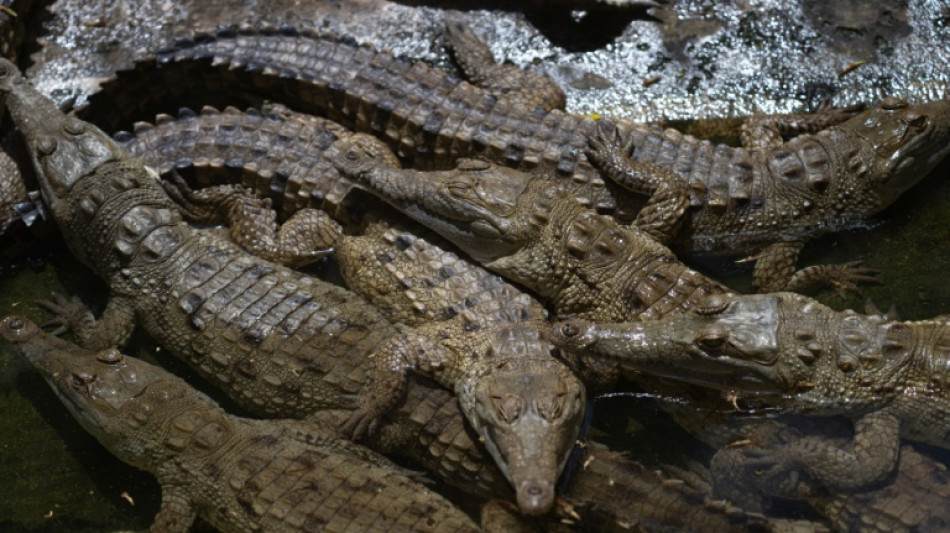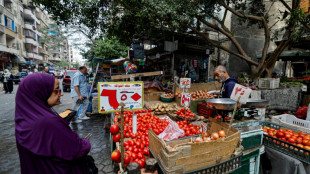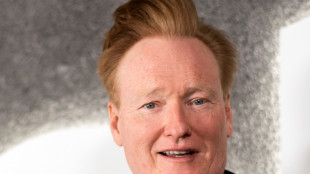
-
 Tractor-driving French farmers protest EU-Mercosur deal
Tractor-driving French farmers protest EU-Mercosur deal
-
Floods hit northern Philippines after typhoon forces dam release

-
 Markets mixed after Wall St losses as traders weigh US rates outlook
Markets mixed after Wall St losses as traders weigh US rates outlook
-
Law and disorder as Thai police station comes under monkey attack

-
 Philippines cleans up as typhoon death toll rises
Philippines cleans up as typhoon death toll rises
-
Long delayed Ukrainian survival video game sequel set for release amid war

-
 Philippines cleans up after sixth major storm in weeks
Philippines cleans up after sixth major storm in weeks
-
Markets swing after Wall St losses as traders weigh US rates outlook

-
 Gabon early results show voters back new constitution
Gabon early results show voters back new constitution
-
Is AI's meteoric rise beginning to slow?

-
 Biden touts climate legacy in landmark Amazon visit
Biden touts climate legacy in landmark Amazon visit
-
Biden clears Ukraine for long-range missile strikes inside Russia

-
 'Nobody can reverse' US progress on clean energy: Biden
'Nobody can reverse' US progress on clean energy: Biden
-
Biden allows Ukraine to strike Russia with long-range missiles: US official

-
 Biden clears Ukraine for missile strikes inside Russia
Biden clears Ukraine for missile strikes inside Russia
-
Ukrainians brave arduous journeys to Russian-occupied homeland

-
 'Devil is in the details,' EU chief says of S.America trade deal
'Devil is in the details,' EU chief says of S.America trade deal
-
Toll in Tanzania building collapse rises to 13, survivors trapped

-
 'Red One' tops N.America box office but could end up in the red
'Red One' tops N.America box office but could end up in the red
-
Biden begins historic Amazon trip amid Trump climate fears

-
 Macron defends French farmers in talks with Argentina's Milei
Macron defends French farmers in talks with Argentina's Milei
-
India and Nigeria renew ties as Modi visits

-
 Typhoon Man-yi weakens as it crosses Philippines' main island
Typhoon Man-yi weakens as it crosses Philippines' main island
-
迪拜棕榈岛索菲特美憬阁酒店: 五星級健康綠洲

-
 The Retreat Palm Dubai MGallery by Sofitel: Пятизвездочный велнес-оазис
The Retreat Palm Dubai MGallery by Sofitel: Пятизвездочный велнес-оазис
-
The Retreat Palm Dubai MGallery by Sofitel: A five-star wellness Oasis

-
 Power cuts as Russian missiles pound Ukraine's energy grid
Power cuts as Russian missiles pound Ukraine's energy grid
-
Biden in historic Amazon trip as Trump return sparks climate fears

-
 India hails 'historic' hypersonic missile test flight
India hails 'historic' hypersonic missile test flight
-
Debt-saddled Laos struggles to tame rampant inflation

-
 India's vinyl revival finds its groove
India's vinyl revival finds its groove
-
Climate finance can be hard sell, says aide to banks and PMs

-
 Egypt's middle class cuts costs as IMF-backed reforms take hold
Egypt's middle class cuts costs as IMF-backed reforms take hold
-
Dinosaur skeleton fetches 6 million euros in Paris sale

-
 Trump's Republican allies tread lightly on Paris pact at COP29
Trump's Republican allies tread lightly on Paris pact at COP29
-
China's Xi urges APEC unity in face of 'protectionism'

-
 Farmers target PM Starmer in protest against new UK tax rules
Farmers target PM Starmer in protest against new UK tax rules
-
UN climate chief urges G20 to spur tense COP29 negotiations

-
 Philippines warns of 'potentially catastrophic' Super Typhoon Man-yi
Philippines warns of 'potentially catastrophic' Super Typhoon Man-yi
-
Tens of thousands flee as Super Typhoon Man-yi nears Philippines

-
 Gabon votes on new constitution hailed by junta as 'turning point'
Gabon votes on new constitution hailed by junta as 'turning point'
-
Tens of thousands flee as Typhoon Man-yi nears Philippines

-
 Is Argentina's Milei on brink of leaving Paris climate accord?
Is Argentina's Milei on brink of leaving Paris climate accord?
-
Fitch upgrades Argentina debt rating amid economic pain

-
 Trump picks Doug Burgum as energy czar in new administration
Trump picks Doug Burgum as energy czar in new administration
-
At summit under Trump shadow, Xi and Biden signal turbulence ahead

-
 Xi warns against 'protectionism' at APEC summit under Trump cloud
Xi warns against 'protectionism' at APEC summit under Trump cloud
-
Xi, Biden at Asia-Pacific summit under Trump trade war cloud

-
 Leftist voices seek to be heard at Rio's G20 summit
Leftist voices seek to be heard at Rio's G20 summit
-
Boeing strike will hurt Ethiopian Airlines growth: CEO


Fighting to save Venezuela's Orinoco Crocodile
Venezuela's Orinoco Crocodile is a fearsome beast, but its enormous size and sharp teeth were no match for humans who hunted them to the brink of extinction.
Millions were slaughtered in the 20th century, mainly for their skins, and today, only about 100 adult females are left in Venezuela, according to the country's Fudeci natural sciences foundation.
Known to scientists as Crocodylus intermedius, the enormous reptile is native to the Orinoco basin that Venezuela shares with Colombia.
It can grow to more than six meters (19.7 feet) in length and over 400 kilograms (882 pounds), making it one of the largest crocodiles in the world.
According to the International Union for Conservation of Nature, it is critically endangered, having suffered an 80-percent population reduction in just three generations in the early and mid-1900s.
More than 2.5 million Orinoco Crocodile skins were exported from Venezuela from 1931 to 1934, according to official Venezuelan figures.
Today, such trade is prohibited but the threat persists: the crocs are killed for their eggs and meat, and sometimes out of fear. And their habitat is ever shrinking and defiled by pollution.
Efforts that started in 1990 to breed new crocs in captivity have seen some 10,000 freed back into the Venezuelan wild.
But their numbers have not significantly increased.
"We do a part... to raise the animals and then release them, but after that it no longer depends on us, there has to be protection of these animals, surveillance, control, there has to be environmental education," conservationist Federico Pantin told AFP.
Pantin, 56, manages the Leslie Pantin breeding zoo -- named after his father who founded it -- with his wife Tuenade Hernandez in the northern state of Aragua. It is one of several croc breeding centers in the country.
- 'Seeds of conservation' -
On Sunday, Pantin was on hand for the release of 160 hatchlings -- small and green-skinned with black spots and light eyes -- into the Capanaparo River.
The zoo's captive breeding pair produces about 40 eggs at a time.
The eggs are incubated for about 90 days in very specific conditions, buried in sand at a depth of 33 centimeters, at a temperature of between 30 and 34 degrees Celsius (86-93 degrees Fahrenheit) and humidity of 85-90 percent.
The crocodiles mostly hatch in May, and at about one year of age, they are freed.
Zoo staff also capture free-born baby crocs in the river to raise them in relative safety.
"Predation in the natural environment is very high" with birds, fish and other reptiles all feeding on the defenseless hatchlings, explained Pantin.
By raising them at the zoo, 95 percent of the hatchlings survive -- whereas most would have died in their natural environment.
"The animals arrive here about 24 centimeters (9.4 inches) long and weighing about 80 or 100 grams (2.8-3.5 ounces)... we release them when they reach about 80 or 90 centimeters and weigh four kilos," said Pantin.
According to Diego Bilbao, director of a company called Rio Verde which organizes tours to witness the annual release of young crocs, the sector holds potential for tourism income with a conservational side benefit.
If locals and Indigenous communities can be convinced to see the crocs as a source of income, he explained, "they help protect it."
The Pantin Zoo, which also works to conserve other threatened species such as the Red Siskin finch, the stubfoot toad and the wood turtle, also seeks to instill a natural stewardship mindset in visiting school groups.
"I love it," said Hernandez of this part of her job. "The seeds of conservation are sown at a young age."
M.P.Jacobs--CPN



